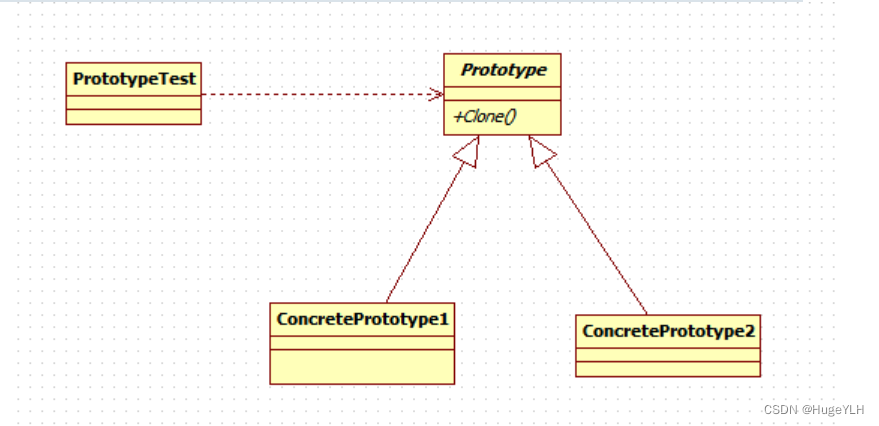C++设计模式:原型模式(详解+实现案例)
原型模式
原型模式:
用原型实例指定创建对象的种类,并通过拷贝这些原型创建新的对象,简单理解就是“克隆指定对象”
使用场景
某些结构复杂的对象的创建工作中由于需求的变化,这些对象经常面临着剧烈的变化,但是他们却拥有比较稳定一致的接口。此时便可以使用原型模式。
实现步骤
- 提供一个抽象原型类:规定了具体原型对象必须实现的接口。
- 提供多个具体原型类:实现抽象原型类的
clone()方法,它是可被复制的对象。 - 提供访问类:使用具体原型类中的
clone()方法来复制新的对象。

案例一
最简单的原型模式,其实就是调用抽象原型类中的clone,使得对象可以直接通过克隆来创建对象。
优点:
- 提高性能
- 避免使用构造函数
#include <iostream> #include <string> using namespace std; //抽象原型类 class Dog { public: virtual ~Dog() {} virtual Dog* clone() = 0; //克隆方法 virtual void play() = 0; //其他公共接口 }; //具体原型类 class Twoha :public Dog { public: Twoha(string name) :name{ name } {} //拷贝构造函数(深拷贝) Twoha(const Twoha& lhs) { //存在指针则必须使用深拷贝 name = lhs.name; } //实现抽象方法 Dog* clone() { return new Twoha{ *this }; } void play() { cout << "我是一只" << name << endl; } private: string name; }; int main() { Dog* dog = new Twoha{ "二哈" }; Dog* Eha1 = dog->clone(); Dog* Eha2 = dog->clone(); Eha1->play(); Eha2->play(); delete dog; delete Eha1; delete Eha2; return 0; }
案例二
//1. 抽象原型类 class Shape { public: virtual ~Shape() {} virtual Shape* clone() = 0; virtual int getid() = 0; virtual string getType() = 0; protected: string Type; private: int id; }; //2. 三个形状具体原型 class Circle :public Shape { public: Circle(string Type, int id) :Type(Type), id(id) {} ~Circle() {} //Circle(const Circle& lhs) { Type = lhs.Type, id = lhs.id; } Shape* clone() { return new Circle{ *this }; } int getid() { return id; } string getType() { return Type; } protected: string Type; private: int id; }; class Rectangle :public Shape { public: Rectangle(string Type, int id) :Type(Type), id(id) {} ~Rectangle() {} Rectangle(const Rectangle& lhs) { Type = lhs.Type, id = lhs.id; } Shape* clone() { return new Rectangle{ *this }; } int getid() { return id; } string getType() { return Type; } protected: string Type; private: int id; }; class Square :public Shape { public: Square(string Type, int id) :Type(Type), id(id) {} ~Square() {} Square(const Square& lhs) { Type = lhs.Type, id = lhs.id; } Shape* clone() { return new Square{ *this }; } int getid() { return id; } string getType() { return Type; } protected: string Type; private: int id; }; //3. 存储对象种类的数据库 class ShapeType { public: ~ShapeType() { for (auto& x : ShapeMap) { delete x.second; x.second = nullptr; } } //构造原始对象 ShapeType() { Circle* circle = new Circle{ "圆形",1 }; Square* square = new Square{"正方形",2}; Rectangle* rectangle = new Rectangle{"矩形",3}; ShapeMap.emplace(circle->getType(), circle); ShapeMap.emplace(square->getType(), square); ShapeMap.emplace(rectangle->getType(), rectangle); } //根据你所需要的种类来获得克隆对象 Shape* getShape(string Type) { return ShapeMap[Type]->clone(); } private: unordered_map<string, Shape*> ShapeMap; }; int main() { //1. 创建对象种类库 ShapeType obj; //2. 从对象库中获得对象的克隆体(getShape函数返回某个对象的克隆) Shape* m_circle = obj.getShape("圆形"); Shape* m_Square = obj.getShape("正方形"); Shape* m_Rectangle = obj.getShape("矩形"); cout << m_circle->getid() << " : " << m_circle->getType() << endl; cout << m_Square->getid() << " : " << m_Square->getType() << endl; cout << m_Rectangle->getid() << " : " << m_Rectangle->getType() << endl; delete m_circle; delete m_Square; delete m_Rectangle; return 0; }

优缺点
优点
- 如果创建新的对象比较复杂,可以利用原型模式简化对象的创建过程,同时也能够提高效率。
- 简化对象的创建,无需理会创建过程。
- 可以在程序运行时(对象属性发生了变化)获得一份内容相同的实例,他们之间不会相互干扰
缺点
- 每一个类都必须配备一个克隆方法,对于已有的没有克隆方法的类来说是致命的。
本文来自博客园,作者:hugeYlh,转载请注明原文链接:https://www.cnblogs.com/helloylh/p/17209627.html






【推荐】国内首个AI IDE,深度理解中文开发场景,立即下载体验Trae
【推荐】编程新体验,更懂你的AI,立即体验豆包MarsCode编程助手
【推荐】抖音旗下AI助手豆包,你的智能百科全书,全免费不限次数
【推荐】轻量又高性能的 SSH 工具 IShell:AI 加持,快人一步
· 从 HTTP 原因短语缺失研究 HTTP/2 和 HTTP/3 的设计差异
· AI与.NET技术实操系列:向量存储与相似性搜索在 .NET 中的实现
· 基于Microsoft.Extensions.AI核心库实现RAG应用
· Linux系列:如何用heaptrack跟踪.NET程序的非托管内存泄露
· 开发者必知的日志记录最佳实践
· TypeScript + Deepseek 打造卜卦网站:技术与玄学的结合
· Manus的开源复刻OpenManus初探
· 写一个简单的SQL生成工具
· AI 智能体引爆开源社区「GitHub 热点速览」
· C#/.NET/.NET Core技术前沿周刊 | 第 29 期(2025年3.1-3.9)